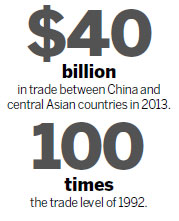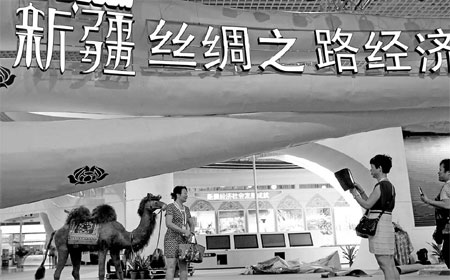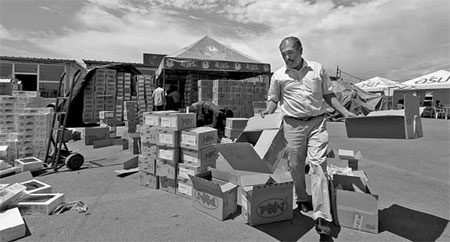Silk Road trade routes ripe for revival
After entering the Horgos International Border Cooperation Center, the first cross-border center of its kind in Eurasia jointly owned by China and Kazakhstan, Sagitov Georgievich contacted his cousin in one of the center's markets to find out where to get the best deals on sport gear and football tops.
Georgievich is one of many Kazakh business travelers who drive hundreds of kilometers from different locations in Kazakhstan to buy Chinese goods in Horgos and sell them back in their home markets.
Horgos is a land entry port and border market connecting China and Kazakhstan, in the Ili Kazakh autonomous prefecture of the Xinjiang Uygur autonomous region.
Its history can be traced back to China's Sui Dynasty (AD 581-618), when the port served as part of the Silk Road trade routes.
About 2,000 years ago, herds of camels carrying goods followed specific routes across Eurasia, crossing mountains and deserts, and linking the continent's east and west sides with silk, jewelry, handicrafts, spices and seeds.
The Silk Road was a collection of practical routes to improve trade and cultural exchanges and they connected China and European countries since 100 BC, with central Asia as the intermediate station.
The route became prosperous in China's Tang Dynasty (AD 618-907), when the capital of ancient China, Chang'an, known today as Xi'an, hosted envoys from more than 70 countries, including foreign government and religious delegations, merchants and overseas students.
Today the sound of trains rushing along tracks replaces the ding of camel bells. With shorter transport times than maritime freight, more Chinese cities use international rail lines, which link many parts of China to Central Asia and Europe and help improve regional connectivity and trade on the Silk Road Economic Belt.
The population of the countries and areas the route covers is nearly 4 billion, representing a big market with huge potential.
The belt connects the Asia-Pacific economies in the east and the European economies in the west.
Countries along the route have great potential to cooperate in fields including infrastructure, transportation, tourism, finance, energy, telecommunication, agriculture and manufacturing.
Chinese goods were previously distributed via container ships and cargo flights to international service centers such as Rotterdam, Hamburg or Frankfurt, in Germany.
From there, goods traveled on long-distance trucks before arriving at destinations such as Moscow, Novosibirsk in Siberia or Astana, the capital of Kazakhstan.
The logistics arrangements put added financial pressure on trade and manufacturing companies at each end of the journey.
Since 2010, major Chinese cities, including Chengdu, Chongqing, Xi'an, Zhengzhou, Wuhan and Yiwu have run weekly or monthly block train services to European and Central Asian destinations. This is part of China's effort to turn its inland resources and labor-rich cities into international trade hubs.
Countries in Central Asia and Eastern Europe, including Kazakhstan, Turkmenistan, Poland and Belarus, are also willing to build new platforms for broader trade as well as business, cultural and technological cooperation with China and other countries along the route.
Trade between China and central Asian countries, including Kazakhstan, Uzbekistan, Tajikistan and Kyrghyzstan, climbed 13 percent year-on-year to $40 billion in 2013, nearly 100 times than that of 1992, data from China's Ministry of Commerce showed.
China is now the largest trading partner of Kazakhstan and Turkmenistan and the second-largest of Uzbekistan and Kyrgyzstan.
Eager to enhance its earning strength, Kazakhstan spent billions of US dollars to design and build a road between west China and west Europe that is expected to become operational in 2015, according to the Consulate General of China in Almaty.
The 8,000-kilometer highway, from China's Horgos to St Petersburg in Russia through Kazakhstan, will become a new trunk line connecting Asia and Europe.
The road will bring opportunities including transportation networks, housing and manufacturing facilities, as the countries involved strive to achieve their goals in infrastructure, urbanization and industrialization.
zhongnan@chinadaily.com.cn

|
Visitors to the booth for the Xinjiang Uygur autonomous region, a key area on both the ancient and modern Silk Road trade routes. Zhu Xingxin / China Daily |
|
A businessman arranges goods at the Horgos International Border Cooperation Center, part of the land entry port and border market connecting China and Kazakhstan. |
(China Daily 09/08/2014 page8)
















